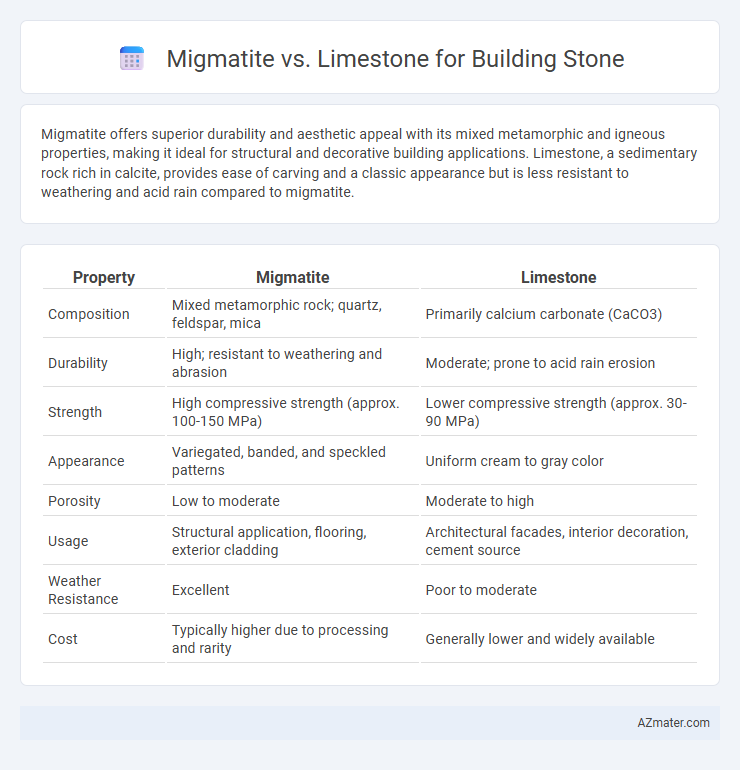Migmatite offers superior durability and aesthetic appeal with its mixed metamorphic and igneous properties, making it ideal for structural and decorative building applications. Limestone, a sedimentary rock rich in calcite, provides ease of carving and a classic appearance but is less resistant to weathering and acid rain compared to migmatite.
Table of Comparison
| Property | Migmatite | Limestone |
|---|---|---|
| Composition | Mixed metamorphic rock; quartz, feldspar, mica | Primarily calcium carbonate (CaCO3) |
| Durability | High; resistant to weathering and abrasion | Moderate; prone to acid rain erosion |
| Strength | High compressive strength (approx. 100-150 MPa) | Lower compressive strength (approx. 30-90 MPa) |
| Appearance | Variegated, banded, and speckled patterns | Uniform cream to gray color |
| Porosity | Low to moderate | Moderate to high |
| Usage | Structural application, flooring, exterior cladding | Architectural facades, interior decoration, cement source |
| Weather Resistance | Excellent | Poor to moderate |
| Cost | Typically higher due to processing and rarity | Generally lower and widely available |
Introduction to Migmatite and Limestone
Migmatite is a high-grade metamorphic rock characterized by a mixed composition of igneous and metamorphic minerals, often exhibiting a banded or foliated texture. Limestone, a sedimentary rock primarily composed of calcium carbonate (CaCO3), forms from the accumulation of marine organism shells and skeletal fragments. Both stones are commonly used in construction, with migmatite valued for its strength and durability, while limestone is prized for its workability and aesthetic appeal.
Geological Formation of Migmatite and Limestone
Migmatite forms through intense partial melting of pre-existing metamorphic rocks during high-grade regional metamorphism, resulting in a mixed texture of igneous and metamorphic components characterized by distinct light and dark bands. Limestone originates primarily from the accumulation of marine organisms' calcium carbonate shells and skeletal fragments in shallow, warm marine environments, undergoing lithification into sedimentary rock. The contrasting geological formation processes influence their mineral composition, durability, and suitability as building stones, with migmatite exhibiting high strength and resistance, while limestone offers ease of shaping but lower weather resistance.
Physical Characteristics and Appearance
Migmatite exhibits a complex, banded appearance with intermingled layers of light and dark minerals, providing a unique, variegated texture favored in decorative architecture. Its high hardness and resistance to weathering ensure durability and strength, making it suitable for structural applications. Limestone features a uniform, fine-grained texture with creamy to gray tones, often displaying fossil imprints, but it is softer and more porous, requiring sealing for longevity in construction.
Durability and Weather Resistance
Migmatite exhibits high durability and superior weather resistance due to its metamorphic origin, making it less prone to erosion and chemical alteration compared to limestone. Limestone, primarily composed of calcium carbonate, is more susceptible to acid rain and physical weathering, which can accelerate surface degradation. For building applications requiring long-term strength and minimal maintenance, migmatite provides a more resilient option in harsh environmental conditions.
Workability for Construction
Migmatite exhibits moderate workability in construction due to its heterogeneous composition, combining both igneous and metamorphic characteristics that provide sufficient strength and durability but require specialized cutting tools for shaping. Limestone offers superior workability, being softer and more homogenous, allowing easier cutting, carving, and shaping, which reduces labor time and costs in building projects. The choice between migmatite and limestone depends on the specific project needs, balancing limestone's ease of use against migmatite's enhanced toughness and weather resistance.
Common Architectural Applications
Migmatite is prized for its durability and unique banded appearance, making it ideal for decorative facades, flooring, and monumental architecture where aesthetic appeal and strength are essential. Limestone, softer and easier to carve, is commonly used in historical buildings, interior cladding, and ornamental columns due to its workability and classic look. Both stones contribute distinct textures and structural qualities, with migmatite favored in high-wear applications and limestone preferred for intricate detailing and traditional architectural styles.
Environmental Impact and Sustainability
Migmatite offers superior durability and resistance to weathering, making it a sustainable choice for long-lasting construction with reduced maintenance demands. Limestone extraction often leads to significant habitat disruption and higher carbon emissions due to intensive quarrying processes. Choosing migmatite over limestone can minimize environmental impact by ensuring greater resource longevity and less ecological disturbance.
Cost Comparison and Availability
Migmatite, formed through high-grade metamorphism, offers greater durability and resistance to weathering than limestone but typically comes at a higher initial cost due to its complex extraction and processing requirements. Limestone is generally more abundant and widely available, making it more cost-effective for large-scale building projects, although it is less resistant to acid rain and physical wear over time. The choice between migmatite and limestone depends largely on budget constraints and the desired longevity and aesthetic of the construction.
Aesthetic Considerations in Building Design
Migmatite offers a unique aesthetic with its striking blend of light and dark mineral bands, creating a visually dynamic texture ideal for feature walls and decorative facades. Limestone provides a smooth, uniform appearance with subtle color variations that contribute to timeless elegance and versatility in both traditional and modern architectural styles. The choice between migmatite and limestone largely depends on the desired visual impact, with migmatite delivering bold complexity and limestone offering understated sophistication.
Choosing the Right Stone for Your Project
Migmatite offers superior durability and resistance to weathering compared to limestone, making it ideal for load-bearing structures and exterior cladding in harsh environments. Limestone's softer texture and chemical composition provide excellent workability and aesthetic appeal, often favored for interior applications, facades, and decorative elements. Selecting between migmatite and limestone depends on project requirements such as structural strength, environmental exposure, and desired finish quality.

Infographic: Migmatite vs Limestone for Building Stone
 azmater.com
azmater.com